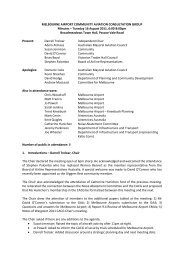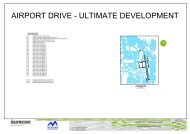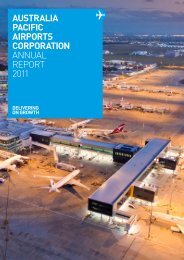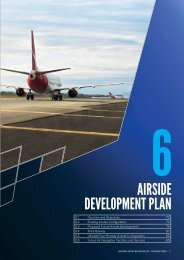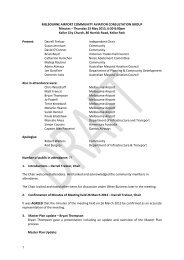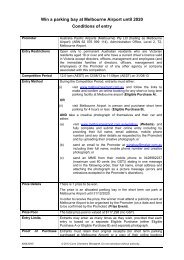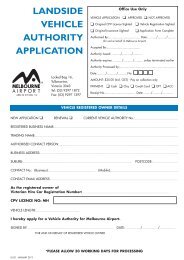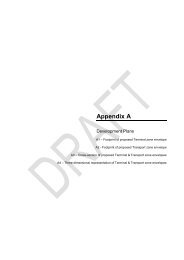Section 9 - Ground Transport Plan - Melbourne Airport
Section 9 - Ground Transport Plan - Melbourne Airport
Section 9 - Ground Transport Plan - Melbourne Airport
You also want an ePaper? Increase the reach of your titles
YUMPU automatically turns print PDFs into web optimized ePapers that Google loves.
The efficiency and effectiveness, in terms of average<br />
vehicle occupancy, of taxi movement within the airport<br />
could be significantly improved. <strong>Melbourne</strong> <strong>Airport</strong> is<br />
committed to working with the Victorian Taxi Directorate,<br />
Taxis Services Commission or relevant authority on<br />
improving taxi movements. Over the next five years, the<br />
airport proposes to encourage and trial new taxi-sharing<br />
initiatives and make improvements to VHA services.<br />
<strong>Melbourne</strong> <strong>Airport</strong> could also benefit from changes<br />
identified in the State Government’s Taxi Industry Inquiry.<br />
The airport will work with the Victorian Government on<br />
implementation of the Inquiry’s recommendations.<br />
9.5.9 Active <strong>Transport</strong><br />
Active transport, where possible, will continue to promote<br />
walking and cycling. This is primarily aimed at providing<br />
active transport opportunities for employees.<br />
The proposed improvements include enhancing the<br />
existing bicycle path network and the quality of existing<br />
network infrastructure, and providing additional end-of-trip<br />
facilities such as safe, accessible storage for bicycles and<br />
change facilities for cyclists. This active transport network<br />
will be significantly improved by constructing a shared<br />
pedestrian and bike path adjacent to the <strong>Airport</strong> Drive<br />
extension, which will link two roads that are currently<br />
part of the Principal Bicycle Network in Sharps Road<br />
and Melrose Drive. The same path will also enable the<br />
airport to be connected to the M80 Ring Road bike<br />
network in the future.<br />
The cycle networks will also benefit from half the traffic<br />
shifting from existing roads to the new elevated loop road<br />
when it is completed. This will provide safer routes into<br />
employment areas and greater separation of pedestrians<br />
and cyclists from vehicles. The details of any opportunities<br />
are currently being investigated as part of the elevated<br />
road network planning project. Specific details are not<br />
yet available as the upper road network routes are being<br />
finalised, which in turn will influence the traffic uses,<br />
capacities and opportunities on the existing roads.<br />
However, active transport improvements are expected.<br />
9.5.10 Freight<br />
As demand increases, freight access to and within<br />
<strong>Melbourne</strong> <strong>Airport</strong> will be improved with the development<br />
of the elevated road network, which will separate freight<br />
vehicles from passenger vehicles. The first steps have<br />
been realised with the recently completed APAC Drive<br />
on-ramp to the Tullamarine Freeway. Over the next five<br />
years, the <strong>Airport</strong> Drive route will be established to<br />
provide access from the <strong>Melbourne</strong> <strong>Airport</strong> Business<br />
Park, rather than direct traffic through the terminal<br />
precinct.<br />
9.6 Future <strong>Ground</strong> <strong>Transport</strong><br />
Implementation System (six–20 years)<br />
Within the six to 20-year period, <strong>Melbourne</strong> <strong>Airport</strong><br />
will commit to implementing the <strong>Ground</strong> <strong>Transport</strong><br />
<strong>Plan</strong>. This will achieve <strong>Melbourne</strong> <strong>Airport</strong>’s vision for an<br />
interconnected ground transport system that supports<br />
safe, efficient and reliable journeys for all modes of<br />
transport and airport users.<br />
DRAFT<br />
In addition to increasing passenger demand and<br />
employment expected at <strong>Melbourne</strong> <strong>Airport</strong>, a number<br />
of external factors will contribute to or affect transport<br />
access. These include an ageing population; the increasing<br />
role of technology; the move towards high-productivity<br />
vehicles for moving goods; limitations on the supply of<br />
non-renewable energy sources; a continued focus on<br />
equity, security and safety; and the potentially increasing<br />
role of the private sector in infrastructure investment.<br />
These external factors will be considered when<br />
implementing the plan.<br />
128




